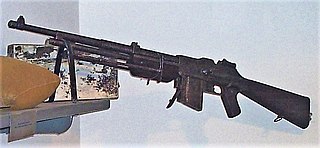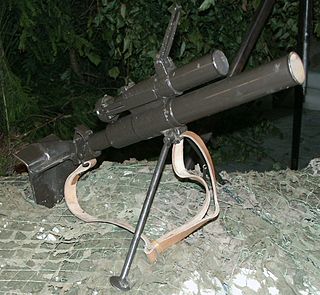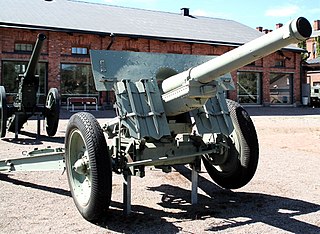
The 7TP was a Polish light tank of the Second World War. It was developed from the British Vickers 6-ton. A standard tank of the Polish Army during the 1939 Invasion of Poland, its production did not exceed 150 vehicles. Its chassis was used as the base for the C7P artillery tractor.

The TK (TK-3) and TKS were Polish tankettes developed during the 1930s and used in the Second World War.

"Mills bomb" is the popular name for a series of British hand grenades which were designed by William Mills. They were the first modern fragmentation grenades used by the British Army and saw widespread use in the First and Second World Wars.

Stielhandgranate is the German term for "stick hand grenade" and generally refers to a prominent series of World War I and World War II–era German stick grenade designs, distinguished by their long wooden handles, pull cord arming and cylindrical warheads. The first models were introduced by the Imperial German Army during World War I and the final design was introduced during World War II by the German Wehrmacht.
The karabinek wzór 1988 Tantal is a 5.45×39mm assault rifle designed and produced in Poland in the late 1980s.

Pistolet maszynowy wz. 39 Mors was a Polish submachine gun designed by Piotr Wilniewczyc and Jan Skrzypiński between 1936 and 1938. It was to have become the standard submachine gun of the Polish Army some time in the 1940s. However, its production was halted by the 1939 Invasion of Poland and World War II.

The Browning wz.1928 is a Polish version of the M1918 BAR. It was a light machine gun used by the Polish Military During World War II.
This article covers the history of Polish Intelligence services dating back to the Polish–Lithuanian Commonwealth.

The hełm wz. 31 was the basic combat helmet of the Polish Army before the outbreak of World War II and during the Invasion of Poland. The helmet became the basic type of combat headgear for Polish military formations in 1930s and during the early stages of World War II. It was also exported to Persia, Albania and Republican Spain. By September 1939 approximately 320,000 copies were delivered to the Polish Army.

The 76.2 mm divisional gun model 1902 was a Russian light field gun used in the Russo-Japanese War, World War I, the Russian Civil War, and a number of interwar armed conflicts with participants from the former Russian Empire. Modernized versions of this gun were employed at the early stage of World War II.

The Canon de 105 mle 1913 Schneider was a French artillery piece used in World War I and World War II by many European countries.

The Granatnik wz.36 was a Polish grenade launcher designed in originally in 1927 as "wz. 30" and later modified in 1936. It entered service in 1936 becoming the standard grenade launcher of the Polish Army; it was still in use during the German Invasion of Poland in 1939.

The Granat zaczepny wz.24 was a concussion grenade used by the Polish Army before and during World War II. The oval egg-shaped shell casing was made of thin sheet metal filled with picric acid or TNT. Initially used with a variety of fuses, since early 1930s the grenade was used with the standard Zapalnik wz. Gr. 31 time fuse designed for the Defensive grenade wz.33. The grenade armed with the wz. Gr. 31 fuse is sometimes referred to as wz. 24/31 to distinguish it from the original wz.24 grenade armed with different fuses.
SEPEWE was a Polish arms industry syndicate. Established as a joint venture of the Polish government and 19 private companies of the arms industry, it became one of the largest arms dealerships of the 1920s and 1930s. Between 1926 and 1939 SEPEWE exported Polish and foreign-made military equipment to over 30 states, obtaining between 320 and 350 million zlotys.

C2P was a Polish light artillery tractor. Designed in the 1930s, it was the basic tractor of Polish anti-aircraft artillery during the 1939 Nazi and Soviet invasion of Poland. There are only two surviving vehicles, both in private hands in Poland.

Samochód pancerny wz. 28 was a Polish armoured car of the 1920s. Based on French-built Citroën-Kegresse B2 10CV half-track chassis, the vehicle became the standard armoured car of the Polish Army. However, due to low speed and problems with reliability, already in 1933 it was decided to return the completed wz. 28 armoured cars to the factory and rebuild them as all-wheel Samochód pancerny wz. 34.

The Armata 75 mm wz.02/06 was a light field gun used by Poland before and during World War II. It began life as the 76 mm divisional gun M1902, a Russian light field gun used in the Russo-Japanese War, World War I, Russian Civil War and Polish–Soviet War.

The 105 mm Armata wz. 29 was a field gun produced in France and Poland that was used by Poland, Nazi Germany, and Finland during World War II.















